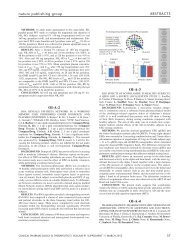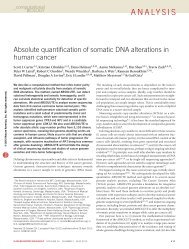open access: Nature Reviews: Key Advances in Medicine
open access: Nature Reviews: Key Advances in Medicine
open access: Nature Reviews: Key Advances in Medicine
You also want an ePaper? Increase the reach of your titles
YUMPU automatically turns print PDFs into web optimized ePapers that Google loves.
any survival benefit or a renal protective<br />
effect. Although the effect on the primary<br />
end po<strong>in</strong>t was similar <strong>in</strong> all subgroups,<br />
the risk reduction was less prom<strong>in</strong>ent <strong>in</strong><br />
patients on dialysis (relative risk 0.90; 95%<br />
CI 0.75–1.08) than <strong>in</strong> nondialysis patients<br />
(relative risk 0.78; 95% CI 0.67–0.91). Thus,<br />
the modest effect on cardiovascular risk <strong>in</strong><br />
patients on dialysis is of a similar magnitude<br />
to that reported <strong>in</strong> previous studies of stat<strong>in</strong>s<br />
(nonsignificant risk reductions of 8% <strong>in</strong> the<br />
4D study and 4% <strong>in</strong> AURORA). Persistent<br />
<strong>in</strong>flammation and comorbidities may <strong>in</strong>fluence<br />
the effects of lipid- lower<strong>in</strong>g treatment<br />
<strong>in</strong> patients on dialysis. Although the precise<br />
role of these factors and the mechanism/s<br />
through which they <strong>in</strong>teract with stat<strong>in</strong><br />
treatment are not yet evident, it can be speculated<br />
that if persistent <strong>in</strong>flammation serves<br />
as a catalyst and magnifies risk, 1 the effect<br />
of long-term stat<strong>in</strong> treatment may differ<br />
<strong>in</strong> patients on dialysis with and without<br />
<strong>in</strong>flammation; these groups should be analyzed<br />
separately. Comorbidities, such as diabetes,<br />
may also <strong>in</strong>fluence the cardiovascular<br />
effects of stat<strong>in</strong> treatment <strong>in</strong> this patient<br />
group. To determ<strong>in</strong>e whether rosuvastat<strong>in</strong><br />
might reduce the risk of cardiac events <strong>in</strong><br />
731 hemo dialysis patients with diabetes, a<br />
post hoc analysis of the AURORA cohort<br />
was performed. 5 Rosuvastat<strong>in</strong> treatment<br />
significantly reduced the rates of cardiac<br />
events by 32% among patients with diabetes.<br />
However, it is a concern that although<br />
there was no difference <strong>in</strong> overall stroke<br />
<strong>in</strong>cidence between the rosuvastat<strong>in</strong> and<br />
the placebo groups, rosuvastat<strong>in</strong>-treated<br />
patients with diabetes had a higher risk of<br />
hemorrhagic strokes than the placebo group<br />
(relative risk 5.21; 95% CI 1.17–23.27).<br />
The high prevalence of atrial fibrillation<br />
is another major cl<strong>in</strong>ical problem <strong>in</strong> dialysis<br />
units. In a recent study based on 2.5 million<br />
observations of hemodialysis patients,<br />
W<strong>in</strong>kelmayer et al. 6 showed that the prevalence<br />
of atrial fibrillation had <strong>in</strong>creased<br />
threefold from 1992 (3.5%) to 2006 (10.7%).<br />
They also showed that mortality was twice<br />
as high among hemodialysis patients with<br />
atrial fibrillation compared to those without<br />
atrial fibrillation. In 2011, the same group<br />
also reported data from 2,313 hemodialysis<br />
patients with new-onset atrial fibrillation.<br />
Whereas patients treated with warfar<strong>in</strong> had<br />
double the risk of hemorrhagic stroke compared<br />
with nonusers, the risk of ischemic<br />
stroke did not differ between users and nonusers<br />
of warfar<strong>in</strong>. 7 As warfar<strong>in</strong> treatment<br />
does not reduce the risk of ischemic stroke<br />
and, <strong>in</strong> addition to <strong>in</strong>creas<strong>in</strong>g the risk of<br />
<strong>Key</strong> advances<br />
■ Inflammation <strong>in</strong>teracts with other<br />
cardiovascular risk factors <strong>in</strong> the<br />
uremic milieu, such as asymmetric<br />
dimethylarg<strong>in</strong><strong>in</strong>e, and <strong>in</strong>creases the risk<br />
of poor outcomes 2<br />
■ Short-term treatment with a recomb<strong>in</strong>ant<br />
human IL-1 receptor antagonist reduces<br />
<strong>in</strong>flammatory biomarkers <strong>in</strong> patients on<br />
hemodialysis 3<br />
■ Lipid-lower<strong>in</strong>g treatment is associated<br />
with beneficial effects on major<br />
atherosclerotic events <strong>in</strong> the entire<br />
chronic kidney disease population;<br />
the effect is less pronounced <strong>in</strong> the<br />
subpopulation of dialysis patients 4<br />
■ The prevalence of atrial fibrillation <strong>in</strong><br />
North American hemodialysis patients<br />
<strong>in</strong>creased threefold between 1992 and<br />
2006 6<br />
■ Whereas warfar<strong>in</strong> treatment does not<br />
reduce the risk of ischemic stroke, it<br />
<strong>in</strong>creases the risk of hemorrhagic stroke<br />
<strong>in</strong> older hemodialysis patients with atrial<br />
fibrillation 7<br />
hemorrhagic stroke, may have a role <strong>in</strong> both<br />
the progression of vascular calcification and<br />
<strong>in</strong> the life-threaten<strong>in</strong>g condition calciphylaxis,<br />
the risks of war far<strong>in</strong> treatment seem<br />
to outweigh its potential bene ficial effects<br />
<strong>in</strong> dialy sis patients with atrial fibrilla tion.<br />
Thus, until an adequately powered RCT<br />
settles the important question as to whether<br />
warfar<strong>in</strong> reduces the overall risk of stroke<br />
and improves survival it seems advisable not<br />
to prescribe vitam<strong>in</strong> K antagonists, such as<br />
warfar<strong>in</strong>, to patients on dialysis with atrial<br />
fibrillation. This f<strong>in</strong>d<strong>in</strong>g should also prompt<br />
the <strong>in</strong>itiation of studies to evaluate the safety<br />
and efficacy of novel anti coagulant treatment<br />
strategies <strong>in</strong> patients with advanced<br />
chronic kidney disease, such as drugs target<strong>in</strong>g<br />
factor IIa (dabigatran) and factor Xa<br />
(rivaroxaban, apixaban and edoxaban)<br />
<strong>in</strong> the coagulation cascade. Indeed, <strong>in</strong> a<br />
recent RCT conducted <strong>in</strong> 18,201 patients<br />
with atrial fibrillation (but without kidney<br />
disease), apixaban was superior to warfar<strong>in</strong><br />
<strong>in</strong> prevent<strong>in</strong>g stroke or systemic embolism,<br />
caused less bleed<strong>in</strong>g, and resulted <strong>in</strong><br />
lower mortality. 8<br />
The effects of the <strong>in</strong>tensity of dialysis on<br />
morbidity and mortality was first studied<br />
<strong>in</strong> the 1981 National Cooperative Dialysis<br />
study, which suggested that a longer hemodialysis<br />
duration aim<strong>in</strong>g at a predialysis<br />
blood urea nitrogen level of 20 mmol/l<br />
resulted <strong>in</strong> less morbidity than a shorter<br />
hemodialysis duration. The results of the<br />
2002 HEMO study 9 showed that aim<strong>in</strong>g<br />
NEPHROLOGY<br />
at a higher dialysis dose did not result <strong>in</strong><br />
signifi cant benefits on mortality or morbidity<br />
(over standard doses) <strong>in</strong> patients<br />
undergo<strong>in</strong>g thrice-weekly hemo dialysis. In<br />
2010, the randomized study by the Frequent<br />
Hemodialysis Network (FHN) studied the<br />
effect of frequent hemo dialysis versus conventional<br />
hemodialysis (six times weekly<br />
versus three times weekly) <strong>in</strong> 245 patients<br />
followed up for 1 year. 10 Frequent hemodialysis<br />
was associated with significant<br />
beneficial effects on the risk of an <strong>in</strong>crease<br />
<strong>in</strong> left ventricular muscle mass and the<br />
risk of worse physical health scores as well<br />
as improved control of hypertension and<br />
hyperphosphatemia. The drawback was<br />
a 71% <strong>in</strong>crease <strong>in</strong> the risk of requir<strong>in</strong>g<br />
<strong>in</strong>terventions related to vascular <strong>access</strong>.<br />
Although frequent hemodialysis is a promis<strong>in</strong>g<br />
modality, the cost–benefit ratio over<br />
longer follow-up periods than <strong>in</strong> the FHN<br />
study rema<strong>in</strong>s to be evaluated.<br />
In conclusion, several studies published<br />
<strong>in</strong> 2011 have provided the nephrology<br />
community with new small pieces of<br />
knowledge to add to the complex puzzle<br />
of the <strong>in</strong>creased risk of premature cardiovascular<br />
death <strong>in</strong> patients on dialysis.<br />
Based on current knowledge, we conclude<br />
that <strong>in</strong>flammatory biomarkers and an<br />
assessment of atrial fibrillation should be<br />
<strong>in</strong>cluded <strong>in</strong> the risk factor profile monitored<br />
by nephrologists. Whereas stat<strong>in</strong><br />
therapy seems to have a modest, but significant,<br />
beneficial effect on cardiac events,<br />
vitam<strong>in</strong> K antagonist treatment cannot be<br />
advocated <strong>in</strong> dialysis patients with atrial<br />
fibrillation until an RCT has proved its<br />
safety and efficacy.<br />
Division of Renal Medic<strong>in</strong>e, Department of<br />
Cl<strong>in</strong>ical Science, Intervention and Technology,<br />
Karol<strong>in</strong>ska University Hospital at Hudd<strong>in</strong>ge,<br />
Karol<strong>in</strong>ska Institutet, SE 141 86 Stockholm,<br />
Sweden (P. Stenv<strong>in</strong>kel, P. Bárány).<br />
Correspondence to: P. Stenv<strong>in</strong>kel<br />
peter.stenv<strong>in</strong>kel@ki.se<br />
Compet<strong>in</strong>g <strong>in</strong>terests<br />
P. Stenv<strong>in</strong>kel declares an association with the<br />
follow<strong>in</strong>g company: Gambro. See the article onl<strong>in</strong>e<br />
for full details of the relationship. P. Bárány declares<br />
no compet<strong>in</strong>g <strong>in</strong>terests.<br />
1. Carrero, J. J. & Stenv<strong>in</strong>kel, P. Of persistent<br />
<strong>in</strong>flammation as a catalyst for other risk factors<br />
<strong>in</strong> chronic kidney disease. a hypothesis<br />
proposal. Cl<strong>in</strong>. J. Am. Soc. Nephrol. 4, S49–S55<br />
(2009).<br />
2. Tripepi, G. et al. Inflammation and asymmetric<br />
dimethylarg<strong>in</strong><strong>in</strong>e for predict<strong>in</strong>g death and<br />
cardiovascular events <strong>in</strong> ESRD patients. Cl<strong>in</strong>. J.<br />
Am. Soc. Nephrol. 7, 1714–1721 (2011).<br />
3. Hung, A. M., Ellis, C. D., Sh<strong>in</strong>tani, A., Booker, C.<br />
& Ikizler, T. A. IL-1β receptor antagonist reduces<br />
KEY ADVANCES IN MEDICINE JANUARY 2012 | S51








